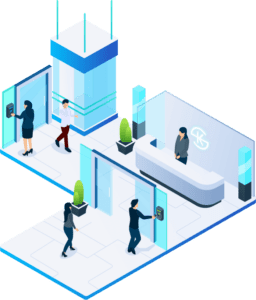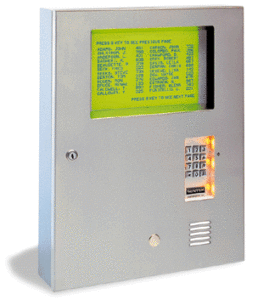Access Control
What is Access Control?
 Access control restricts how and when people enter and/or exit an area. Your particular needs will determine how that is accomplished. Access Control Systems allow people or vehicles into a restricted area via identification through coded keys, magnetic cards, or biometric readers such as hand, face, voice, finger of retina readers. These systems are used in many businesses, hotels and apartment complexes.
Access control restricts how and when people enter and/or exit an area. Your particular needs will determine how that is accomplished. Access Control Systems allow people or vehicles into a restricted area via identification through coded keys, magnetic cards, or biometric readers such as hand, face, voice, finger of retina readers. These systems are used in many businesses, hotels and apartment complexes.
Why should we use Access Control?
![]() Access control systems allow you to control who goes where, to document where and when they went into each area, to automatically lock or unlock doors at certain times and restrict access to those visitors, residents and/or employees who are supposed to be there. Access control is the only technology that proactively attempts to keep unauthorized individuals out of a building or areas within a facility, and is a perfect complement to video surveillance, burglar and fire systems in a comprehensive security solution.
Access control systems allow you to control who goes where, to document where and when they went into each area, to automatically lock or unlock doors at certain times and restrict access to those visitors, residents and/or employees who are supposed to be there. Access control is the only technology that proactively attempts to keep unauthorized individuals out of a building or areas within a facility, and is a perfect complement to video surveillance, burglar and fire systems in a comprehensive security solution.
Common Features Of Access Control Systems
- Limit access– Systems can be programmed to allow certain users to enter specific areas only at certain times. Other users can be allowed to enter all locations at all times.
- Automating – Systems can automatically lock a door or gate each evening at a certain time and unlock it automatically at another time.
- Replace the Key– Managing keys can be a nightmare. If you use a different key for each of several doors it can be cumbersome to carry them all and time consuming to stand at an entrance wading through the set for the right one. Keys are easily lost or duplicated, and terminated employees often do not return keys. Access control systems eliminate this concern because if a user leaves without returning their access credential, it can be easily deleted to deny the former user access. In some systems that access can even be changed from an off site location. In many cases the annual cost of re-keying a facility alone will justify the cost of an electronic access control system.
- Track Access– One of the biggest advantages of an electronic access control system is the ability to document and report access activity. This can provide you with critical information before and after an incident.
- Visual Verification– By including color coded distinctive badges access systems can readily identify visitors, temporary employees, contractors and regular full time employees. By including a photo of the user on the credential you can help building occupants know the card user is the person to whom it was issued.
- Integration and Coordination– Your Access Control System can be connected and coordinated with other systems including burglar and fire alarms, closed circuit television, time and attendance recording, and control of your heating, ventilation and air conditioning systems.
Common Parts of the Access Control System
Each system will have a lock or a barrier, a credential and a credential reader. Many systems will also record the activity of who went where and when.
How Does An Access Control System Work?
First we need a barrier to prevent someone from entering or exiting, such as a locked door or gate. Next we need a way to determine who is trying to enter. A credential reader is used to read the information on a key or card, to register a combination of numbers entered on a pad or to identify some characteristic that the user has, such as a fingerprint the shape of a hand, a pattern in the eye, etc. This identifier is sent to a controller that has stored a record of those identifiers that are authorized to enter the area. If the credential holder is authorized the controller unlocks the gate or door and the credential holder is allowed to enter. In many systems a record of all authorized and unauthorized credentials is stored in the system for future reference.
How Access Control Systems Coordinate With Other Systems
Anything that can be controlled with electricity can be coordinated or controlled with an access control system. Doors can be unlocked automatically in the event of a fire to allow all occupants to exit as fast as possible. Cameras can zoom in on a door when people enter or exit. An alert can sound in a guard office when a certain person enters. Heat or air conditioning can be turned off after the last person leaves or turned on if a person enters after hours.
How Are Access Control Systems Governed by Law?
Many states require companies installing locks or access control systems to be licensed. National and local building codes and fire ordinances usually regulate the use of locking devices. One must remember that these are usually minimum requirements and that the local authorities may have the last word in interpretation and exceptions. Always check with local authorities BEFORE installing any locks. Once installed, it can be quite expensive to replace the locks and repair doors and door frames. There are specific requirements for how you exit a building, which types of locks can be used, what will happen in a power failure and what happens in the case of a fire alarm. These requirements can vary based on how you will use the building. This is the area where a training professional can be of the most help to you.
How Do You Handle Visitors if All Your Doors Are Locked?
If you know when a visitor will be coming you may be able to arrange to get them a temporary credential before or when that arrive. If you have a guard or reception desk where visitors can report this may be a simple solution. If a visitor arrives unexpectedly, intercoms or phones can be used at a central entry point to allow the visitor to communicate with someone so they can be taken care of. Some systems will allow the person that the visitor calls to unlock a door through the phone.
What is Time and Attendance?
The same credential that is used to open a door can be used to record when a person enters a job site to start work for the day and when they leave. Reports can be generated to help in tabulating payroll.
What are Telephone Entry Systems
 Telephone Entry systems are commonly used in multi-tenant buildings that hold offices, condos or apartments. A directory unit is placed at a door that can be used to contact building occupants. It may have a list of occupants and a code number that is dialed or may connect the visitor tot he tenant as a button by their name is pushed. Some of these systems use autodialers to dial a stored phone number when the particular tenant is selected other connect directly to a phone or intercom unit in each tenants location.
Telephone Entry systems are commonly used in multi-tenant buildings that hold offices, condos or apartments. A directory unit is placed at a door that can be used to contact building occupants. It may have a list of occupants and a code number that is dialed or may connect the visitor tot he tenant as a button by their name is pushed. Some of these systems use autodialers to dial a stored phone number when the particular tenant is selected other connect directly to a phone or intercom unit in each tenants location.
Auto-dialer systems:
- require a dedicated phone line from the local phone company.
- will not work for a tenant if the tenant his/her phone service discontinued or if he/she simply does not have any phone service.
- require users to have call waiting service from the local phone company.
- may not work while a phone line is used to connect to the internet.
- need to be reprogrammed when tenants move out or in.
Hardwired telephone entry systems are immune to most of these problems. By tying directly into the existing telephone wirelines inside the building at the lobby level (as opposed to a dedicated subscriber phone line) they allow relatively inexpensive install.
